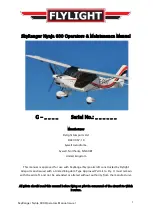
Aeropro CZ - A240 - Pilot Operating Handbook and Flight Training Supplement
September 1, 2014
5-29
5.2.1 Use of external power supply
The aircraft is not provided with a connection for an external power supply - the external power supply
may be connected to battery contacts when necessary. Normally, maintaining the aircraft battery with a
good charge and in a good condition is all that is necessary for proper operation.
5.2.2 Engine starting
- preflight inspection
COMPLETED
- safety belts
ADJUST AND SECURE
- brakes
CHECK FUNCTION
- control stick
FREEDOM OF MOVEMENT
- trim
FREEDOM OF MOVEMENT
- wing flaps
FREEDOM OF MOVEMENT, RETRACTED
- engine controls
FREEDOM OF MOVEMENT
- instruments
CHECK THE VALUES AND SETTINGS
- doors
CLOSED, LOCKED
- master switch
SWITCH ON
- main fuel valve
OPEN
- wing tank fuel values
BOTH OPEN
- choke
SWITCH ON (COLD ENGINE ONLY)
- throttle
HALF A TURN OPEN (idle when choke is used)
- control stick
PULLED (clamped between legs)
- brakes
ON
- propeller area
“CLEAR”
- ignition (mag) switches
BOTH ON
- master switch
STARTER (8 seconds as maximum without interruption,
followed by a cooling period of 1 minute)
- after starting the engine, adjust speed to smooth operation
– avoid exceeding 3000 RPM until 90
F
oil temperature had been achieved.
- instruments
CHECK READINGS (oil pressure must rise within 10 seconds.
Increasing the engine speed is permitted only at a steady oil
pressure reading of above 30 psi)
- choke
OFF (usually it is best to remove the choke gradually as the rpm will
drop as the choke is removed. The throttle may need adjusting as
the choke is removed.)
- avionics and other switches
SWITCH ON (radio, transceiver, etc.)
WARNING:
The aircraft has a tendency to roll forward easily on paved surfaces even when the engine is
at idle. A tailwind is also a significant factor. Make sure that the aircraft is not moving once the engine
is started. If the aircraft is rolling and cannot be stopped with brakes, turn the engine immediately off
using ignition switches.
5.3 Taxiing
5.3.1 Prior to taxiing
Be aware of the entire area around the aircraft to ensure that the aircraft will clear all obstructions and
other aircraft. When first beginning to taxi, the brakes should be tested for proper operation as soon as
the aircraft is put in motion. If braking action is unsatisfactory, the engine should be shut-down
immediately.
















































